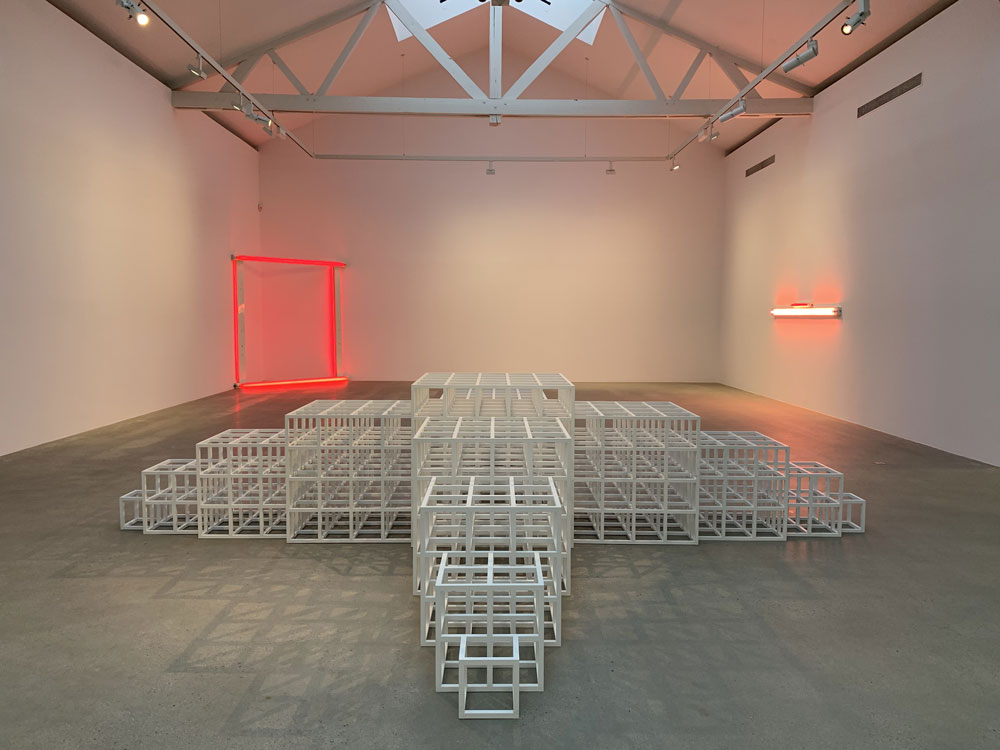Albert Oehlen - Sexe, religion, politique | Max Hetzler & Gagosian
Albert Oehlen is a difficult artist to love, but an easy artist to admire. This is due to his tendency to treat his painting as an intellectual exercise within strict self-imposed boundaries, rather than a vehicle of sensual pleasure. This tendency is on show in a pair of identically- titled exhibitions in two of Paris’ most prestigious private galleries: Max Hetzler and Gagosian.
Each exhibition features works with a near-identical yellow hue: clearly another deliberately-imposed restriction from Oehlen. Each work consists of two rectangular pieces of alubond, put together to form a square, with each side 2.6 metres long. Each uses oil and lacquer. Each has an annoyingly, deliberately throwaway title: Operation Radication, Bam Bam (below), Natty Dread Something. Hard not to see that as more audience-goading from the artist.

They’re mainly portraying black “tree branches” - part of Oehlen’s long-running Baumbilder (tree painting) sequence.
The backgrounds are lividly yellow - too chemical and sickly to be happy sunshine. The paint for the tree branches is sometimes rigid, sometimes fluffy, sometimes a gas cloud. The lines themselves are computer generated.
In some, there is ghostly overpainting of thin yellow paint on top of the black branches. In most, the black paint drips down vertically, like condensation on a window. Taken together, in both medium-sized, high-end galleries, in posh parts of Paris, they have an undeniable power and presence. The titles might seem random, but Oehlen’s line is absolutely controlled.
Max Hetzler’s show notes fancifully compare the artist to Piet Mondrian - something about the planes of his lines - but to me he’s closer to his compatriot Sigmar Polke, in his intentional ugliness that doesn’t quite disguise his craft and skill.
“I see the tree as a program for my work, not just as a motif.” Oehlen has said. It’s hard to love a program. But, yes, a program is easy to admire if executed well.
Other Highlights
I went to a whole bunch of commercial gallery shows during my trip to Paris, of which probably the most objectively impressive was Monumental Minimal, at Thaddeus Ropac’s barn-like space in Pantin. All the big Minimal movement names - Flavin, André, LeWitt, Judd - are there. The show’s premise, demonstrating the European influence, via Tatlin and Albers, on this most American of schools, was sound. But I was a bit turned off, as usual, by the heavy macho humourlessness of the art itself.

Another big American beast, Lawrence Weiner, was showing at Marian Goodman. I found Sylvie Fleury’s similarly monumental reconstructions of makeup palettes, with a delectable sheen of glitter, a nice counterpoint to all that testosterone. She showed at Thaddeus Ropac’s other gallery in the Marais.
Though maybe things moved a bit too far into whimsy at Sophie Calle’s show of new work at Perrotin. This included a photo series and LP in dedication to her dead cat: teeth-clenchingly twee. Across the river, I enjoyed Tatiana Trouvé’s rigorous assemblages of plexiglas, marble and metal at Kamel Mennour.
There was a really impressive Burri retrospective at Tornabuoni Art. I’d known the artist for his Dubuffet-like affection for using rough materials - like sacking and pumice - and for his Manzoni-like nihilism, burning his canvases into blackness. The invaluable show notes pointed out that the burlap sacks were actually ubiquitous during World War Two, and Burri’s use of them could well have come from his anger at Italy’s post-war dependence on subsidies.

He found great delicacy in his final works (pictured): very shallow reliefs made from insulation material.
There were a couple of big-name photography shows on. First, Candida Höfer’s arid photos of fancy spaces at VnH, and David LaChapelle’s bonkers Letter to the World at Templon. He’s been living in the Hawaiian jungle for the past 10 years, apparently - and producing biblical scenes staged by muscly boys and girls in his trademark ultra-saturated style.
Finally, three artists whose names are new to me. Atul Dodiya, an Indian artist inspired by Morandi who also paints beautiful Fresco-style Hindu deities. (Also at Templon.) Kon Trubkovich, a Russian painter of singularly offbeat and sinister portraits - often themselves projected on deliberately distorted black and white photos (at VnH)
And finally Yves Zurstrassen: who paints machine-like patterns through stencils, in the jazzy style of some Saul Bass-scored 50s film credits. That one was at Xippas.
Albert Oehlen: Sexe, religion, politique is at Max Hetzler & Gagosian (Paris). 13 October to 21 December 2018